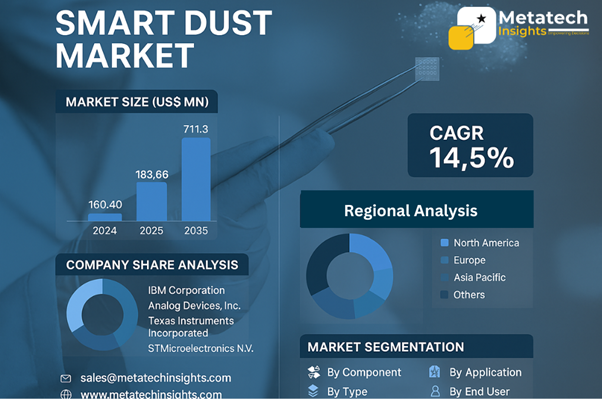Global Smart Dust Market to Hit USD 711.3 Million by 2035 | CAGR 14.5%
09 Aug 2025 | Report ID: MI3071 | Industry: Novel Technology | Pages: 216 | Forecast Year: 2025-2035

Read more about this report- Global Smart Dust Market to Hit USD 711.3 Million by 2035 | CAGR 14.5%
The Smart Dust Market is valued at USD 160.40 million in 2024. The Smart Dust Market will achieve USD 711.3 million by 2035 through a projected 14.5% CAGR from 2025 to 2035.
The growing demand for real-time data and miniaturised sensors in industrial automation and defence systems is the market's fundamental growth driver. Another factor is the technical complexity, and the cost of integrating the smart dust systems into established infrastructures is a major restraint. One of the big opportunities is, however, the increasing application of smart dust in environmental developments and emerging smart cities, where extremely small wireless sensors provide low-power applications that can be scaled.
Their market is segmented by component (sensors, microelectromechanical systems (MEMS), communication systems, and power supply), type (active, passive), application (industrial, military & defence, environmental monitoring, healthcare, and logistics), and end-user (government and private enterprise or research institutions). One of the segments that is shaping up is the environmental monitoring segment because there have been rising concerns regarding climate and continuous tracking of the air and water quality in the cities.
Examples of applications are in the fields of industry automation, battlefield surveillance, distance sensing, predictive systems, medical diagnostics, and environmental monitoring. Within healthcare, there is an increasing interest in in-body diagnostics through the use of biocompatible smart dust motes that communicate directly with one another wirelessly and give real-time physiological data. It has been fuelled by contributing factors such as greater funding of biomedical nanotechnology research, such as the micro-sensor integration programs of the U.S. NIH.
The geographical segmentation is deployed to the market as North America, Europe, Asia-Pacific, Latin America, the Middle East, and Africa. North America controls the market because they have robust military investment, intelligent infrastructure developments, and adoption of IoT capabilities at an early stage. In Asia-Pacific, Japan is leading the way with smart factory programs and university-based MEMS R&D that is enabled through the Ministry of Economy, Trade and Industry (METI).
The key competitors in the market of smart dust are Honeywell International Inc., IBM Corporation, Hitachi Ltd., MetaSensor Inc., and NanoSense Tech Ltd., which is hypothetical. Examples of market leaders are miniaturisation of MEMS, battery-less communication, and integration of edge computing by these companies, and strategic partnerships in specific sector aspects of the market, defence, logistics, and smart manufacturing.
Maximize your value and knowledge with our 5 Reports-in-1 Bundle - over 40% off!
Our analysts are ready to help you immediately.
